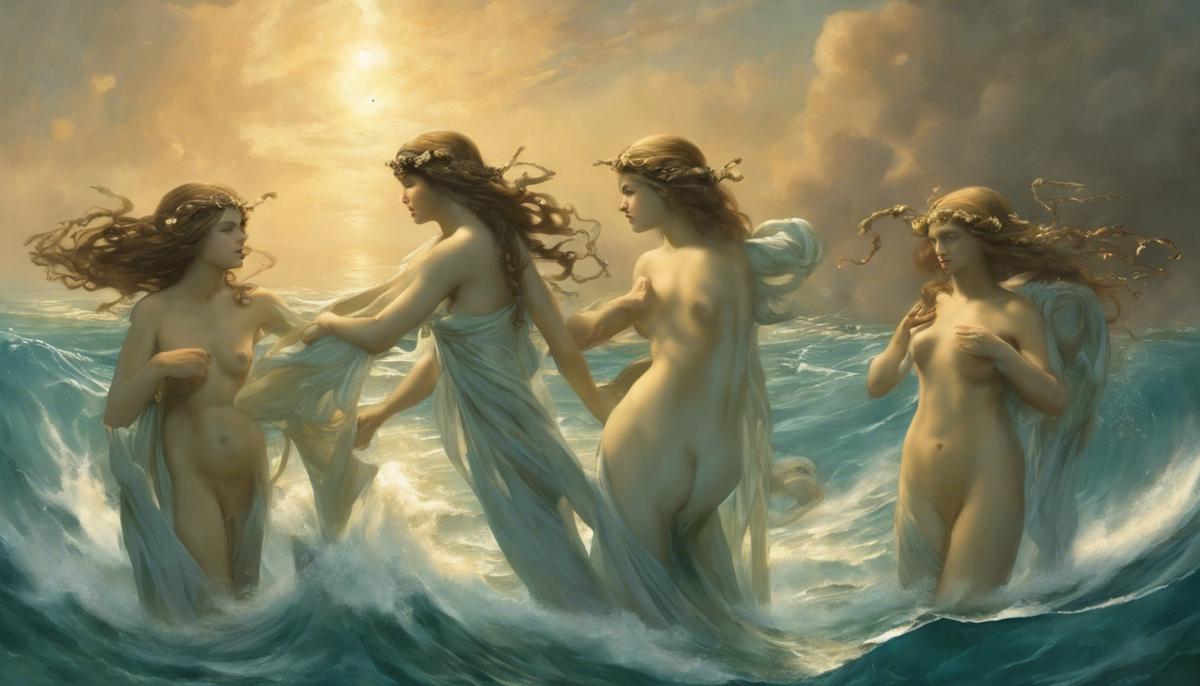The Oceanids, divine nymphs and daughters of Oceanus and Tethys, play pivotal roles in Greek mythology and daily life. These personifications of nature and human existence offer a unique perspective on the interplay between the divine and the mundane.
Origins and Family
Oceanus, the world-encompassing river, and Tethys, the sea goddess, stand as the parents of the Oceanids. Their combined powers nurtured their offspring to become personifications of the earth's waters. Among their progeny were the 3,000 Oceanids, known for their beauty and grace, and the Potamoi, the river gods.
The Oceanids, personifying all sources of freshwater, and their riverine brothers underscore the Greeks' understanding of their environment. Each sibling held a distinct part in natural governance, beckoning devout worshippers and curious minds to reflect on the interconnectedness of earthly and divine elements.
This celestial family, linked by their vital role in engraining mythical essence into natural elements, ensures that every brook's babble and ocean's roar find echoes in the halls of Mount Olympus and beyond.
Roles and Realms
The Oceanids' roles swirled with variety, weaving their magical functions into the fabric of daily human and divine affairs. As curators of life-sustaining elements like rivers, streams, and springs, they embraced roles as handmaidens to deities such as Artemis and Hera.
Their philanthropic portfolio extended their earth-bound roles, merging spirituality with freshwater streams. They fashioned atmospheres suitable for prophecies and romantic interludes, adorning natural vistas with divine provisions and intrigue. The Oceanids' realms were places of interaction—spaces where gods, heroes, and mortal tribes oscillated between mere existence and epicness through sacred connections with freshwater resources.
Philosophy and lore also fell under their influence. Intellectual currents proliferated wherever springs sprang or rivers carved pathways, contributing to the development of early Hellenistic musings on life governed by the elemental. The Oceanids, iconic and embedded within Greek culture, made observers wonder whether water itself was divine, showing clearest where civilization overlapped with lessons in deity-derived environmental stewardship.

Famous Oceanids
In the whirlpool of Greek myth, some Oceanids rose to particular prominence. Metis, the epitome of wisdom, had an ill-fated romance with Zeus. Swallowed by Zeus, fearful of a son who would usurp his throne, Metis nonetheless defined divine maternity by fashioning armor for Athena.
Styx, the somber goddess whose river forms the boundary between Earth and the Underworld, allied with Zeus during the titanomachy. As a thank you, Zeus granted her river oaths their irreversible powers, making her a decisive figure in cosmic gatekeeping.
Dione played a tender, nurturing role beside Zeus, earning a place as 'mother' in different versions of Aphrodite's origins. Her presence at Zeus's side during critical moments at Dodona's oracle reminds us that even a whispering spring may carry weighty prophecies.
Poseidon, god of earthquakes and seas, courted several Oceanids, merging his mighty realms with their riverine ones. Amphitrite and Doris, sometimes tied to Oceanid lineage, illustrate how even potent seas may seek alliance with clear flowing springs for stability and influence across aqueous domains.
These tales blend the essential with the extraordinary, reflecting humanity's awe of nature's omnipotence. Each story enfolds deeper reflections on existence, inviting us to ponder the currents that carved our landscapes both physical and philosophical.
Cultural Impact
The Oceanids were vital to the cultural fabric of ancient Greece, echoing through rituals, artistic expressions, and civic life. Their quiet essence permeated personal aspects of human existence, symbolizing life-giving forces within community and home.
Worshipped for their collective abilities to nourish and sustain, the Oceanids took center stage in everyday worship. Small shrines and natural spots blessed by Oceanid grace were places of quiet reflection and gentle offerings. This quotidienne veneration etched their presence into the hushed moments of Greek life.
Artistically, Oceanids danced across pottery and sculpted marble. Fountains and springs, believed to be their haunts, were decorated with scenes depicting these divine nymphs, reminding citizens of their omnipresent, safeguarding gaze.
Oceanids also found their influence shed in literature. Poets loved hurling these nymphs into verses where the finer, sweeter elements of life required a divine nod. In epics, Oceanids were placid backdrops, their powers weaving through foundational myths and narratives.
Their indelible imprint persists into contemporary media. Their versatility makes them apt metaphors in poetic discourse about nature or serenity. Cinema, literature, and even videogames that plumb myth for lore-rich settings or characters find Oceanids a fitting choice.
The disarming subtlety with which they infused the ancient world's ethos on purity and environmental responsibility spirits toward us through time. As metaphors for nature conservation to psychological introspection, Oceanids glide gracefully through modern narratives, underscoring our continuing romance with myth and reminding us of a time when the divine was a daily double, serenely believed to reside beside every spring and stream.
Beyond the footnotes of epic tales, the Oceanids shape an understated narrative—interwoven with humans as benevolent nurturers pivotal to life's poignancy and perpetual movements. Engaging with these legends invites a modern reunion with nature, artistry, and narrative, masterfully delivered on wavelets whispered by nymphs numbering three thousand strong.

The Oceanids exemplify more than just mythological characters; they are integral to understanding ancient Greek culture and its profound connection with nature. Their roles and stories offer insights into how mythology reflects and shapes human interaction with the natural world, reminding us of the enduring power of these narratives to influence our perception of life and environment.
- Atsma AJ. Oceanids. In: Theoi Greek Mythology. Theoi Project; 2000-2017.
- Trzaskoma SM, Smith RS, Brunet S. Anthology of Classical Myth: Primary Sources in Translation. Hackett Publishing; 2004.
- Hard R. The Routledge Handbook of Greek Mythology. Routledge; 2003.
- Larson J. Greek Nymphs: Myth, Cult, Lore. Oxford University Press; 2001.

Leave a Reply